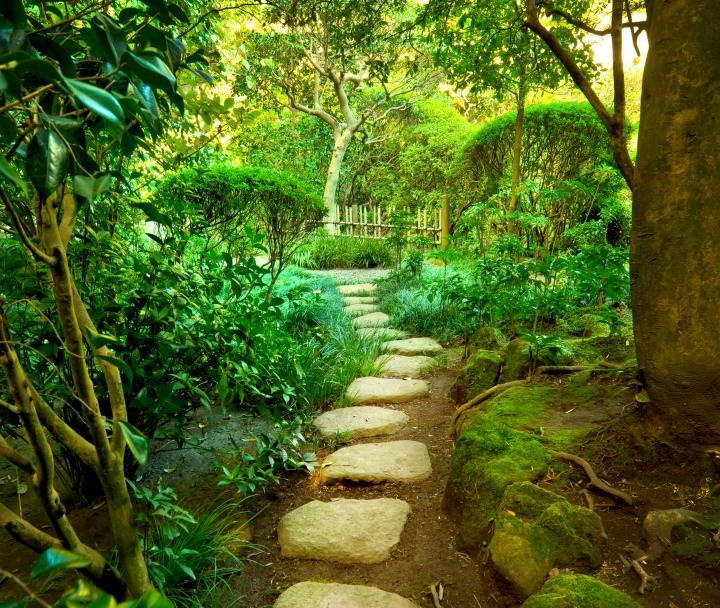Ever wonder what to do with rocks in your yard or garden? You may find that they seem to turn up each year, even in garden soil that you thought was cleared. Here are a few creative ideas on how to use both rocks and stones in your landscape.
A MOUND OF HERBS
A garden of culinary herbs brings joy to many home cooks. Many culinary herbs that are native to the Mediterranean thrive in rocky soil.
Lavender, marjoram, oregano, parsley, rosemary, sage, and thyme, for example, prefer stony settings. Their ideal bed would be a stone–strewn Mediterranean mound that enables the plants to send down deep roots to absorb water while keeping their crowns high and dry.
- To build such a mound, mark off and excavate the area, setting the soil aside.
- Remove 4 to 5 inches of soil in a 12–inch–wide path around the perimeter.
- Dig the bed down 1 foot below the level of the path.
- Amend the excavated soil by mixing in a wheelbarrow–full each of grit, rock rubble, and compost.
- Return the soil to the bed, shaping it into a mound.
- To add interest, place a few large rocks on the mound.
- Plant herbs, along with a selection of other Mediterranean plants, putting those that will grow tallest and require good drainage high on the mound and setting low growers that tolerate more moisture lower.
- Mulch between the plants and around the bed with gravel or organic matter such as wood chips.
Cover the path around the bed with permeable landscaping fabric (to prevent weeds) and several inches of coarse gravel to allow rainwater to penetrate and provide deep–water reserves for the plants.
STEPPING–STONES
A row of stepping–stones that is overplanted with ground covers can turn a well–trodden footpath into a whimsical, decorative pathway. Large (1– to 2–foot-wide) stones with rough surfaces and at least one flat side work best. Avoid marble and shale; both can be slick when wet.
- Place your stones on the ground more or less where you want the path. Set each stone individually: Note the shape and depth of the stone’s underside.
- Dig a hole slightly larger and deeper than the stone itself, setting aside the soil.
- Put several inches of sand into the hole; the sand will make it easier to situate the stone so that it is level with the path.
- Place the stone with the flat side up, adjusting its angle and height.
- Measure the distance to the next stone by taking a step using a normal stride.
- Set the next stone as above and repeat the process.
- Amend the excavated soil with compost, if necessary, and fill around the stones with it. If you need to, remove additional sod from between the stones to plant low–growing ground covers.
Blue star creeper, Irish moss, mazus, and creeping Jenny (all hardy) stand up to being stepped on, feel good on bare feet, and will keep the mud down when it rains.
A STONE PATIO
As a natural, beautiful surface for an outdoor space, nothing beats a stone patio. This is a relatively easy project, but it will require continued maintenance as stones shift over time. Use flagstone or stones that are flat on at least one side.
- Mark off the proposed patio area and try it out.
- Place outdoor furniture in the space for a few days or weeks and note the traffic pattern as well as the space.
- When you’re ready to start, excavate the area to a depth of 6 inches.
- Fill with 2 inches of gravel and tamp it down to level it.
- Cover the area with a layer of permeable landscaping fabric.
- Edge the perimeter with wood, brick, or metal and then lay down approximately 2 inches of sand (the depth of the sand depends on the thickness of your stones).
- Situate the stones firmly in the sand, with the flattest side up, adding more sand underneath, if necessary, to cradle oddly shaped stones.
- Sweep sand between the stones and wet the area.
- Repeat with sand and water until the surface is flush.
TYPES OF ROCK
If you end up orderning rock from a landscape company, understand the different types of rock.
- Rubble is rock of irregular sizes.
- Pebbles are pea– to kiwi–size round or oval stones.
- Gravel is an aggregate of small stones; sizes, shapes, and colors vary. Crushed gravel has sharp edges and resembles rubble; uncrushed gravel is pebbly and round.
- Grit is rough, hard, sand or rock particles.
- Sand is finer than gravel but larger than dust. Beach sand is round and smooth; sharp sand has edges (it is used for building projects).
Source / The Old Farmer’s Almanac

